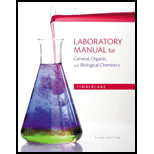
Concept explainers
a.
To determine:
The given solution are isotonic, hypotonic, or hypertonic with physiological solution.
Introduction:
Osmotic pressure is the pressure produced by the solute particles that are dissolved in a solution. As the number of particles in a solution increases, osmotic pressure increases.
An isotonic solution is known as physiological solution as it exerts the same osmotic pressure as red blood cells.
A hypotonic solution has lower osmotic pressure than red blood cells and causes water to flow into the red blood cells and causes RBCs to swell.
A hypertonic solution has higher osmotic pressure than red blood cells and causes water to flow out of red blood cells and causes RBCs to shrink.
b.
To determine:
The given solution are isotonic, hypotonic, or hypertonic with physiological solution.
Introduction:
Osmotic pressure is the pressure produced by the solute particles that are dissolved in a solution. As the number of particles in a solution increases, osmotic pressure increases.
An isotonic solution is known as physiological solution as it exerts the same osmotic pressure as red blood cells.
A hypotonic solution has lower osmotic pressure than red blood cells and causes water to flow into the red blood cells and causes RBCs to swell.
A hypertonic solution has higher osmotic pressure than red blood cells and causes water to flow out of red blood cells and causes RBCs to shrink.
c.
To determine:
The given solution are isotonic, hypotonic, or hypertonic with physiological solution.
Introduction:
Osmotic pressure is the pressure produced by the solute particles that are dissolved in a solution. As the number of particles in a solution increases, osmotic pressure increases.
An isotonic solution is known as physiological solution as it exerts the same osmotic pressure as red blood cells.
A hypotonic solution has lower osmotic pressure than red blood cells and causes water to flow into the red blood cells and causes RBCs to swell.
A hypertonic solution has higher osmotic pressure than red blood cells and causes water to flow out of red blood cells and causes RBCs to shrink.
d.
To determine:
The given solution are isotonic, hypotonic, or hypertonic with physiological solution.
Introduction:
Osmotic pressure is the pressure produced by the solute particles that are dissolved in a solution. As the number of particles in a solution increases, osmotic pressure increases.
An isotonic solution is known as physiological solution as it exerts the same osmotic pressure as red blood cells.
A hypotonic solution has lower osmotic pressure than red blood cells and causes water to flow into the red blood cells and causes RBCs to swell.
A hypertonic solution has higher osmotic pressure than red blood cells and causes water to flow out of red blood cells and causes RBCs to shrink.
Want to see the full answer?
Check out a sample textbook solution
Chapter 8 Solutions
EBK LABORATORY MANUAL FOR GENERAL, ORGA
- Calculate the pH and the pOH of each of the following solutions at 25 °C for which the substances ionize completely: (a) 0.000259 M HClO4arrow_forwardWhat is the pH of a 1.0 L buffer made with 0.300 mol of HF (Ka = 6.8 × 10⁻⁴) and 0.200 mol of NaF to which 0.160 mol of NaOH were added?arrow_forwardDetermine if the following salt is neutral, acidic or basic. If acidic or basic, write the appropriate equilibrium equation for the acid or base that exists when the salt is dissolved in aqueous solution. If neutral, simply write only NR. Be sure to include the proper phases for all species within the reaction. NaN₃arrow_forward
- A. Draw the structure of each of the following alcohols. Then draw and name the product you would expect to produce by the oxidation of each. a. 4-Methyl-2-heptanol b. 3,4-Dimethyl-1-pentanol c. 4-Ethyl-2-heptanol d. 5,7-Dichloro-3-heptanolarrow_forwardWhat is the pH of a 1.0 L buffer made with 0.300 mol of HF (Ka = 6.8 × 10⁻⁴) and 0.200 mol of NaF to which 0.160 mol of NaOH were added?arrow_forwardCan I please get help with this.arrow_forward
- Determine if the following salt is neutral, acidic or basic. If acidic or basic, write the appropriate equilibrium equation for the acid or base that exists when the salt is dissolved in aqueous solution. If neutral, simply write only NR. Be sure to include the proper phases for all species within the reaction. N₂H₅ClO₄arrow_forwardPlease help me with identifying these.arrow_forwardCan I please get help with this?arrow_forward
 Chemistry: Principles and ReactionsChemistryISBN:9781305079373Author:William L. Masterton, Cecile N. HurleyPublisher:Cengage Learning
Chemistry: Principles and ReactionsChemistryISBN:9781305079373Author:William L. Masterton, Cecile N. HurleyPublisher:Cengage Learning Introduction to General, Organic and BiochemistryChemistryISBN:9781285869759Author:Frederick A. Bettelheim, William H. Brown, Mary K. Campbell, Shawn O. Farrell, Omar TorresPublisher:Cengage Learning
Introduction to General, Organic and BiochemistryChemistryISBN:9781285869759Author:Frederick A. Bettelheim, William H. Brown, Mary K. Campbell, Shawn O. Farrell, Omar TorresPublisher:Cengage Learning Chemistry: Principles and PracticeChemistryISBN:9780534420123Author:Daniel L. Reger, Scott R. Goode, David W. Ball, Edward MercerPublisher:Cengage Learning
Chemistry: Principles and PracticeChemistryISBN:9780534420123Author:Daniel L. Reger, Scott R. Goode, David W. Ball, Edward MercerPublisher:Cengage Learning General, Organic, and Biological ChemistryChemistryISBN:9781285853918Author:H. Stephen StokerPublisher:Cengage Learning
General, Organic, and Biological ChemistryChemistryISBN:9781285853918Author:H. Stephen StokerPublisher:Cengage Learning ChemistryChemistryISBN:9781305957404Author:Steven S. Zumdahl, Susan A. Zumdahl, Donald J. DeCostePublisher:Cengage Learning
ChemistryChemistryISBN:9781305957404Author:Steven S. Zumdahl, Susan A. Zumdahl, Donald J. DeCostePublisher:Cengage Learning





